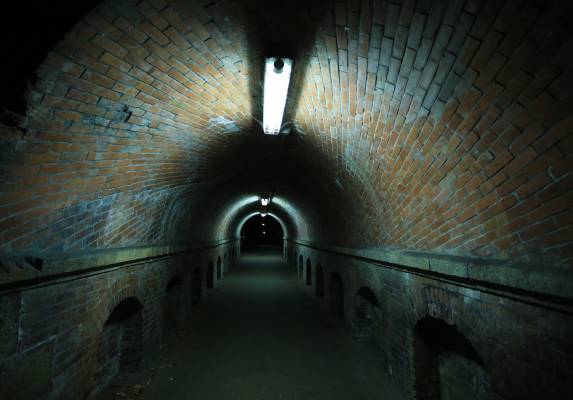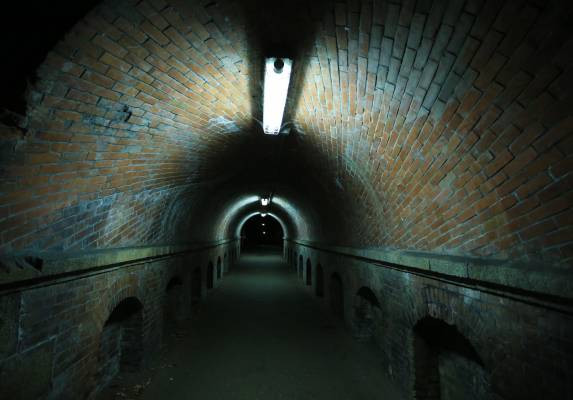
The secret tunnel that runs beneath the Forth

Edinburgh has no shortage of hidden depths, and the tunnel that once ran under the Forth is one of the most fascinating
Like Edinburgh Castle, the Royal Mile and the other iconic landmarks across the city of Edinburgh, the Firth of Forth is famous throughout the world. As part of Edinburgh’s rich tapestry of sights and spectacles, it has its fair share of history behind it.
Today, the 3 Forth bridges that sit astride the estuary spring to mind for many of us when we first think of the Forth. But did you know that below the surface lies another mode of travel, one that houses an incredible past?
The story of the tunnel below the Forth is a prime example of the hidden depths to Scotland’s capital and its surrounding areas. So sit back and enjoy this slice of Scottish history.
The forgotten tunnel
Picture the scene:
The constant roar of the drill finally dying away, dust and rubble forming plumes in the air before settling on the ground below the glow of the miners’ lamps, two men wiping the sweat from their brows and greeting each other with a sing-song “Hello!”
This was a particularly important greeting, for the two men were meeting each other for the first time as the two ends of the tunnel connected for the first time. This winding tunnel stretched for miles beneath the Forth.
This scene took place in the early morning in the April of 1964. It marked the completion of the meandering tunnel that had been two years in the making and which took passengers from Bo’ness on the edge of West Lothian to Valleyfield in Fife.
The completion of the Forth tunnel 500 metres below the sea turned a long sought-after dream into a reality. By creating a shortcut between the south and north side of the river, the aim of the tunnel was to revolutionise the coal industry throughout Scotland.
In fact, the tunnel was the brainchild of the National Coal Board, designed to make use of the modern coal facilities across the river at Kinneil, instead of having to rely on the outdated plant at Valleyfield.
So what happened to the tunnel that spanned one of the Britain’s most famous rivers, and why does hardly anyone know of its existence today?
Alistair Moore was an engineer working on the tunnel’s creation back in the 1960s. Speaking to the Edinburgh Evening News back in 2015, at the age of 82, he could recall the experience with startling clarity, including the complex and laborious preparations that went into his calculations.
It was Alistair’s job to accurately calculate the tunnel’s measurements in order to ensure that the two sides of the structure actually connected in the middle. This left him a tiny margin of error to work with.
He said:
“I was due to go on holiday. I thought there was about twenty-five feet to go but I was going on holiday for a fortnight. My boys were young and we were going up to Aberdeenshire.
“The manager said, ‘You’re not going anywhere, you’re staying here.’ So I thought, ‘Let’s get this done quickly so I can get my holidays.’”
Alistair even remembers rushing to work at 6am on the morning of April 30th to witness the final stretch first-hand.
He recalled: “The boys were working with a big jack hammer which used compressed air. You couldn’t hear a thing. I’m watching them and all of a sudden they were crashing in and there was a wee hole, just three inches in diameter and the drill went shooting through. We were in.
“I put my mouth near the hole, as close as possible and I shouted ‘Hello!’ and got back this ‘Hello!’ from the other side.”
Although joining two stretches of tunnel together sounds reasonably straightforward, the complexity of it lay in getting the levels to match almost exactly.
Alistair said: “It wasn’t a tunnel in a straight line. It wasn’t a route that you could ever just walk straight through. This was a tunnel associated with the coal seams under the Forth, with angles and slopes – a fairly convoluted system of roadways.
It needed manholes every thirty yards – a cubby hole for a person to shelter in when a locomotive was coming through. It wasn’t at all a straight tunnel.”
Thanks to men like Alistair, the two sides of the tunnel connected with a mere six inches of difference. This was an incredible feat, given that there weren’t any technological advancements to help with the calculations. Alistair’s number-crunching relied on pencil, paper, plumb lines and the trig pillar situated on top of Arthur’s Seat.
“As the crow flies, the distance between north and south would be about 1.8 miles, but we had about 2.5 miles of works to make the connection between the two. We had to get the levels correct, which it was to about six inches – quite a nice feather in our cap. The next was to make sure that the connection from Valleyfield was in line with us. And it was.
“There were no computers or calculators. All we had was a machine called a Brunsviga. You put one set of numbers on one side and pulled the lever and the other figures on the other side and puled the level again a certain number of times, depending on what you were working out.
“It was primitive. Not just that, most people would use four-figure log tables, mine was eight-figure, the log book was four inches thick.”
But the hard work paid off. After the first small breakthrough, the two mine managers were called out along with union officials, press reporters and the provost of Bo’ness.
Martin ‘Tiger’ Shaw, a 23-year-old miner, did the honours, while Valleyfield miner Andrew Drysdale waited patiently on the other side.
The Edinburgh Evening News reported the excitement surrounding the scene, saying: “The drill in the hands of Tiger Shaw began biting through the thin sandstone shell, the last barrier in the tunnel link at 10.30 am.
“Three minutes later, the lamps of the Valleyfield squad blinked through the gap in the rock and Shaw and Drysdale were face to face.”
The pair grinned at each other as they stepped back and allowed the two managers to stand on their respective sides and shake hands at the meeting point.
Alistair, however, hadn’t the time to hang around. He said: “I didn’t bother with all that. I was off on my holidays.”
With such a remarkable story behind it, it’s strange that so few of us are aware that a tunnel ever existed
Today, anybody trying to use or find the tunnel will be disappointed. Like the coal industry it aimed to serve, the tunnel’s existence is now not much more than a memory. Thanks to the sheer power of the river itself, the tunnel is little more than ruins.
But it’s important to remember, when you next cross one of the iconic bridges soaring over the water, that below those grey depths a group of men once tunnelled for miles and greeted each other in the place where two halves met.
The Forth tunnel is just one of the many fascinating stories that Scotland’s capital has to offer. If you wish you lived closer to all the action in the heart of the city, why not take a tour of Quartermile and tour our luxury new-build apartments in Edinburgh’s most exciting new district. Simply call 0845 000 25 25 or email This email address is being protected from spambots. You need JavaScript enabled to view it. .



